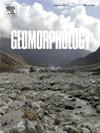Northeastward thrust propagation accommodated by the Minle oblique ramp at the northern edge of the Qilian Shan in the northeastern Tibetan Plateau
IF 3.1
2区 地球科学
Q2 GEOGRAPHY, PHYSICAL
引用次数: 0
Abstract
The different segments of thrust faults are typically connected by linking faults (e.g., lateral ramps, tear faults, or oblique ramps) that accommodate the differential movement and transfer stress in step-over zones. However, the activities and deep structures of linking faults on the Tibetan Plateau have received limited attention in previous studies. The Minle Fault, a strike-varying oblique ramp on the northeastern margin of the Tibetan Plateau, offsets multiple terraces of the Yudai and Hongshui Rivers and accommodates the deformation in the step-over zone between two thrust faults. In this study, 132 vertical offsets and partial strike-slip offsets along the Minle Fault were measured based on high-precision DEM, a terrace chronology framework was established using AMS 14C dating, and a 2D kinematic model was constructed based on the surface fault offsets. The results indicate linear increasing vertical offsets along strike on each terrace, a listric deep structure with a flat detachment depth of ∼2.5 km, and a late Quaternary dip-slip rate of ∼1.1 mm/a for the Minle Fault. The Minle Fault, a thin-skinned oblique ramp formed during the Quaternary following the protrusion of the Yumu Shan, poses a potential earthquake hazard. On the actively growing Tibetan Plateau dominated by large strike-slip and thrust faults, the linking faults between them serve as critical adjusted structures, constituting an essential component in the evolution of the orogenic belt.
青藏高原东北部祁连山北缘民乐斜斜坡发育的东北向逆冲扩展
逆冲断层的不同部分通常通过连接断层(例如,侧向斜坡、撕裂断层或斜斜坡)连接起来,这些断层可以适应不同的运动,并在跨台阶带中传递应力。然而,以往的研究对青藏高原连接断裂的活动和深部构造关注较少。民乐断裂带是青藏高原东北缘一条走向变化的斜斜斜坡,与玉岱河和红水河的多个阶地相抵消,并容纳两条逆冲断层之间的台阶带变形。基于高精度DEM测量了闽乐断裂带132条垂直偏移和部分走滑偏移,利用AMS 14C测年技术建立了台地年代学框架,并基于地表断层偏移建立了二维运动学模型。结果表明,各阶地沿走向垂直偏移呈线性增加,为滑脱深度为~ 2.5 km的盘状深部构造,民乐断裂晚第四纪的倾滑速率为~ 1.1 mm/a。闽乐断裂是第四纪玉木山隆起后形成的薄皮斜斜断裂带,具有潜在的地震危险性。在以大型走滑逆冲断层为主的活跃生长的青藏高原上,走滑逆冲断层之间的联结断裂是重要的调整构造,是造山带演化的重要组成部分。
本文章由计算机程序翻译,如有差异,请以英文原文为准。
求助全文
约1分钟内获得全文
求助全文
来源期刊

Geomorphology
地学-地球科学综合
CiteScore
8.00
自引率
10.30%
发文量
309
审稿时长
3.4 months
期刊介绍:
Our journal''s scope includes geomorphic themes of: tectonics and regional structure; glacial processes and landforms; fluvial sequences, Quaternary environmental change and dating; fluvial processes and landforms; mass movement, slopes and periglacial processes; hillslopes and soil erosion; weathering, karst and soils; aeolian processes and landforms, coastal dunes and arid environments; coastal and marine processes, estuaries and lakes; modelling, theoretical and quantitative geomorphology; DEM, GIS and remote sensing methods and applications; hazards, applied and planetary geomorphology; and volcanics.
 求助内容:
求助内容: 应助结果提醒方式:
应助结果提醒方式:


